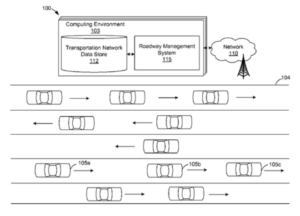Navigating the Highway Network as a Self-Driving Car
As a future with self-driving cars draws near, it seems like more and more companies are trying to make their mark in this undefined space. Most recently, Amazon received a patent for their work on a highway network that manages the way self-driving cars navigate reversible lanes. The idea is detailed in a recent article published on Recode.net. Essentially, the idea describes a highway network that gives autonomous vehicles specific lane assignments on the roadway. The benefit is that the lanes are reversible; at different times of the day or to reduce congestion after a car accident, the direction of traffic flow for any lane can be switched.

Figure: A drawing from Amazon’s patent detailing the differing lane assignments for the self-driving vehicles.
The current highway network, with on and off ramps and intersections as nodes and roadways as edges, serves the current way we drive quite effectively. However, self-driving cars provide an opportunity to rethink the current network, just as Amazon is doing. In the traditional highway network, edges are directed, in that traffic only flows one way on either side of a road. In Amazon’s new network, these directed edges can be flipped, simply by giving the self-driving cars a different lane assignment. In other directed networks, reversing a directed edge could be thought of as removing the edge and then adding the reversed edge. For example, on Twitter or Instagram, this would be like person A unfollowing person B at the same time person B follows person A. In Amazon’s highway network, the idea is similar: close the lane to southbound traffic and open it to northbound traffic, for example. If all cars on the roadway were self-driving, there would not need to be any signs or notifications to indicate the lane reversal, since the computers could simply assign cars to appropriate lanes.
Prior to reading this article, it seemed to me that designing a network was relatively straightforward: choose the nodes, choose the edges, and determine if the edges are directed or undirected. However, the article brings to light the idea that restructuring the way a network is designed could be incredibly valuable for meeting the goals of the network. What other ways could the highway network, or any network, be transformed in previously unthought of ways?